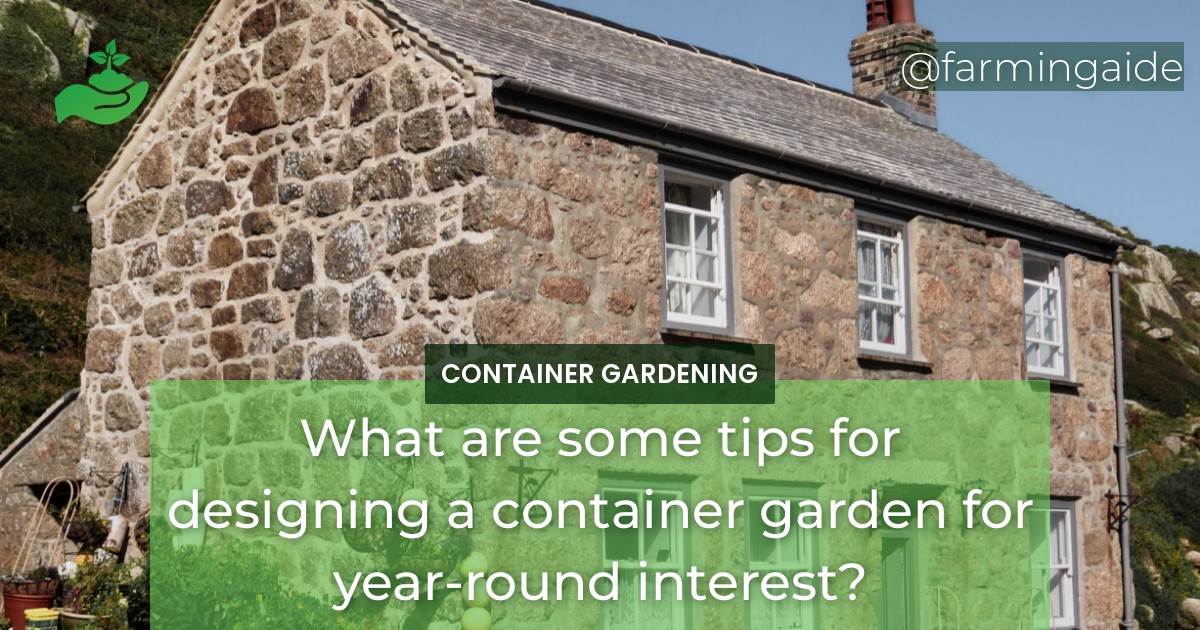Tips for Designing a Container Garden for Year-Round Interest
Container gardening is an excellent way to add color and life to any outdoor space, no matter the season. With some thoughtful planning and a little creativity, you can design a container garden that provides year-round interest and beauty. Here are some tips to get you started:
Choose the Right Container
Consider the Size and Material
Before selecting your plants, you must first choose the right container. Opt for a container that is large enough to accommodate the mature size of your plants. Terra cotta pots, wooden planters, and plastic containers are all excellent choices. Keep in mind that dark-colored containers can get hot and dry out the soil faster than light-colored containers.
Ensure Adequate Drainage
Good drainage is crucial for container gardens. Be sure your container has drainage holes, or you can drill them yourself if necessary. Additionally, consider elevating your container slightly to allow adequate airflow, which helps keep your plants healthy.
Select the Right Plants
Choose Plants with Varied Flowering Seasons
When choosing your plants, select a variety of species that bloom at different seasons to provide colorful blooms all year round. For example, you can plant daffodil bulbs for early spring blooms and add late-blooming plants like chrysanthemums and asters for a colorful autumn display.
Select Plants with Varied Foliage Color and Texture
Consider adding plants with colorful foliage and interesting textures. These can include succulents, ornamental grasses, and colorful foliage plants like heucheras, hostas, and coleus. Plants with contrasting foliage colors can add depth and visual interest to your container garden.
Include Evergreen Plants for Year-Round Interest
Evergreen plants provide year-round interest to your container garden, even in the depths of winter. Consider adding conifers, boxwoods, or hollies to your container garden mix.
ALSO READ
Plan for the Seasons
Choose Plants that Thrive in Your Climate
Choose plants that are well-suited to your local climate. If you live in an area with hot summers, select heat-tolerant plants like succulents, yuccas, and agaves. For colder climates, consider adding winter-hardy plants like pansies and ornamental cabbage.
Swap Out Plants for Each Season
As the seasons change, swap out your plants to keep your container garden looking fresh and interesting. Try swapping out summer annuals for fall mums and cabbages or switching out your winter greens for spring bulbs.
Use Accessories to Add Interest in the Off-Season
Add accessories like trellises, statues, or garden ornaments to your container garden to keep it interesting during the off-season. You can also add lights and other decorative items to create a festive atmosphere during the holidays.
Consider the Container Garden’s Location
Determine the Amount of Sun Exposure
Most plants require a minimum of six hours of sunlight each day to thrive. Determine the amount of sun exposure your container garden will receive and choose plants that are suited to those light levels.
Consider the Surrounding Environment
Take into account the surrounding environment when selecting plants for your container garden. If your container garden is located near a busy street, choose plants that can tolerate pollution. If it’s in a sheltered area, you may want to select plants that can handle windy conditions.
Be Mindful of Temperature
Temperatures can fluctuate significantly depending on the location of your container garden. Be mindful of the temperature extremes in your area and choose plants that can tolerate those conditions. For example, if you live in an area with hot summers and cold winters, select plants that can handle both.
ALSO READ
Plant and Maintain Your Container Garden
Use High-Quality Potting Soil
Use high-quality potting soil in your container garden. Quality potting soil is well-draining and contains a balanced mix of nutrients to keep your plants healthy.
Fertilize and Water Regularly
Regular fertilization and watering are essential for container gardens. Use a high-quality fertilizer and water your plants thoroughly when the soil feels dry to the touch.
Prune and Deadhead Plants as Needed
Regular pruning and deadheading will help keep your container garden looking neat and healthy. Remove dead or yellowing leaves and spent blooms to promote healthy growth and encourage new blooms.
How can I incorporate year-round interest in a tiered container garden design?
When planning a tiered container garden, consider using a variety of plants with different bloom times. Incorporating evergreen shrubs, flowering perennials, and seasonal annuals can create year-round interest. Make sure to choose plants with varying heights and textures to add depth and visual appeal to your design.
Conclusion
Designing a container garden for year-round interest requires some planning, but the effort is well worth the reward. With the right container, plants, accessories, and care, you can create a beautiful and vibrant container garden that provides color and interest all year long.
RELATED ARTICLES:


